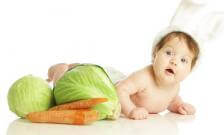Are Fruits and Vegetables Getting Less Nutritious?
Farming can deplete soil of valuable nutrients. What’s the effect on your health?

Is Our Soil Depleted of Nutrients?
If you’ve been reading this column for any length of time, you probably know that I believe that you’re usually better off getting your nutrition from real food than from dietary supplements. There are some cases where supplements make sense. (For more om supplements, see my articles Multivitamins, What are the Benefits of Vitamin D?, and Fish Oil and Omega-3s.) For the most part, though, if you’re eating a healthy diet, you really shouldn’t need to take handfuls of vitamins as well. But what about this idea that we need supplements to make up for the fact that fruits and vegetables are less nutritious than they used to be? Has our soil become depleted of nutrients and rendered our food supply nutritionally bankrupt?
It is true that growing crops removes nutrients from the soil. Over time, soil that’s farmed intensively and constantly can become depleted of certain nutrients. Although farmers add nutrients back to the soil in order to maintain the productivity of the land, they might not always replace everything that’s been depleted.
For example, fruits and vegetables absorb minerals from the soil that aren’t required for healthy plant growth but do contribute to the health of the animals and humans that eat those plants. Over time, these nutrients will become depleted. But if they don’t noticeably affect crops, farmers might not bother to replenish them. As a result, the level of nutrients in fruits and vegetables could decline. That’s the theory, anyway. So, what’s the evidence?
What’s the Evidence that Fruits and Vegetables Have Gotten Less Nutritious?
A couple of studies, one in England and one in the U.S., attempted to compare nutrient data collected in the and 50s and 60s with more recent nutrient analyses. Both studies found differences. For example, the British study found that the calcium content of modern vegetables was about one-fifth lower than what was measured in the 1960s and average copper content declined almost 80%. The U.S. study, which was more carefully controlled, found that amounts for a few nutrients like vitamin C, iron, and riboflavin declined somewhat, several were the same, and a few actually increased.
There are a lot of factors that influence the nutritional value of fruits and vegetables—and I think many of them are actually trending in a positive direction.
These studies are widely—but very selectively—cited in books, articles, and websites that sell nutritional supplements. You never see any mention of the fact that the level of some nutrients has apparently increased in the last 50 years, for example. Instead,
the 80% decline in copper levels observed in the British study is frequently translated as, “Fruits and vegetables have lost 80% of their nutritional value,” which is obviously a gross mischaracterization of the findings.
Why the Levels of Nutrients in Fruits and Vegetables Differs
The authors of both studies are very candid that most of the differences are probably explained by factors other than nutrient depletion of the soil—and it’s not at all clear that these changes pose a problem. For example, the dramatic decline in copper levels in vegetables from 1960 to 1990 is probably because copper-based pesticides, which were widely used then, are not as commonly used now.
When you actually read the studies, it becomes clear that a lot of the differences are most likely the result of changes in sampling methods and measurement techniques, geographical variation, and the random variation in nutrient values from one pepper or strawberry to the next—which is much more significant than most people realize.
Can We Grow More Nutritious Fruits and Vegetables?
But the biggest factor of all appears to be that we simply grow different varieties than we used to. Vegetables have been intensively bred to increase yield, decrease time to harvest, and have greater resistance to pests and disease—but not to improve nutrient content. That, by the way, is changing fast. As consumers become more focused on nutrition, they’re now concentrating on breeding fruits and vegetables that boast higher nutritional value.
There’s also been a big resurgence in heirloom varieties, lately—people are returning to strains that may be more similar to those we were growing back in the 1950s and 60s. And, finally, as concerns about mineral depletion have been raised, many organic and biodynamic farmers and gardeners are taking steps to replenish the soil with mineral-rich amendments like rock dust, in addition to the regular organic fertilizers. See also Are Organic Vegetables Healthier? and Are Organic Foods Worth the Cost?
My point is that there are a lot of factors that influence the nutritional value of fruits and vegetables—and I think many of them are actually trending in a positive direction. In the meantime, even if some vegetables are a little lower in certain minerals, I don’t think this is as big a deal as some people think. In my opinion, skimping on your veggies poses a far more present danger to your nutritional well-being than nutrient-depleted soil. As long as you’re eating a healthy diet with nice variety of fresh fruits and vegetables, you should still have your bases covered. See also my article How to Get More Vegetables in Your Diet.
Feel free to post comments and questions below or on my Nutrition Diva Facebook Page. I answer a lot of listener questions in my free weekly newsletter, so if you’ve sent a question my way, be sure you’re signed up to receive that.
Have a great week and remember to eat something good for me!
References
Historical changes in the mineral content of fruits and vegetables
Mayer, Anne-Marie. British Food Journal. Vol 99, No 6, 207 (1997)
Changes in USDA Food Composition Data for 43 Garden Crops, 1950 to 1999 Donald R. Davis, PhD, FACN, Melvin D. Epp, PhD and Hugh D. Riordan, MD. Journal of the American College of Nutrition Vol. 23, No. 6, 669-682 (2004)
https://www.jacn.org/cgi/content/abstract/23/6/669


